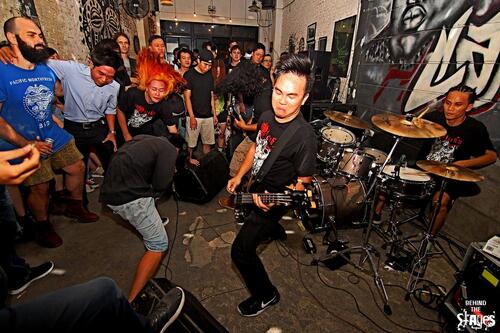Vietnamese Heavy Metal: Past and Present

Vietnamese Heavy Metal: Past and Present
In “Metal Never Dies: America’s Music Legacy in Vietnam”, Soraya Kishtwari describes the evolution and current place of heavy metal, as both a musical genre and subculture, in contemporary Vietnam. The article references a recent documentary on the subject, entitled “Saigon Metalhood.” Historically, the genre of rock had no real foothold in Vietnam before the war. With the arrival of American troops, South Vietnam was exposed to U.S. culture and music from stationed military personnel and through technology like the radio. Interestingly, Kishtwari notes how the resulting popularity of rock and roll with South Vietnamese youth reflected their ultimate desire for an, “alternate Vietnam,” not necessarily the “American dream.” I believe this is an important distinction to make, because we have a tendency to assume that all western cultural products lead inevitably to the West. In reality, there is a necessary step of translation which must occur. It’s from translating the ideas of rock and roll to their own beliefs and experiences that these Vietnamese youth created their own meanings from the music.
As the war began to be viewed more and more critically from the American perspective, this change in mood was also reflected in the music listened to by U.S. troops and by youth in South Vietnam. Kishtwari writes that metal, with its anger and energy, “provided them with an outlet through which to vent their frustrations,” a universal emotion that had separate socio-political sources for Americans and South Vietnamese. With the withdrawal of U.S. forces and reunification came a renewed suppression of western culture, pushing the Vietnamese metal community mostly underground. It is interesting to consider how the government’s desire for a “purification” of Vietnamese culture seems to suggest the viewpoint described earlier, that the intake of western cultural products entails the wholesale acceptance of western culture. I would argue that the actual consequence, barring propaganda, is a kind of cross-cultural dialogue. In the case of the U.S., however, that dialogue is often one-sided; that relationship itself can become a sort of propaganda.
In Vietnam, relaxations on government controls eventually opened the doors to European rock, but it wasn’t until relations with the U.S. began to thaw that Vietnamese metal bands began to see a broader resurgence. Importantly, these bands and those that followed made the music uniquely their own. Kishtwari describes a “Vietnamization” of metal, involving cultural values of family, the incorporation of traditional instruments, and subject material relevant to the tensions of Vietnamese society. I believe this supports the notion of cultural translation, but what some might call a Vietnamization of metal others might consider a westernization of Vietnamese music. In my opinion, this distinction is unimportant—what matters is not the perceived causes of this cultural expression, but its impact on the people themselves.
Challenges remain for Vietnamese metal, such as the limited popularity of the genre and difficulties staging concerts. Because of the way that the genre has arisen in Vietnam, as opposed to its more gradual evolution in American culture, one fan describes the Vietnamese metal scene as “immature”—drug use is a persistent problem. Young people in Vietnam today also have a very different understanding of the world than when metal first arrived: one writer calls the American war an “anachronism” in the eyes of contemporary Vietnamese youth. Despite these difficulties, an essential fact about metal is that it speaks to an emotion which is not historically or culturally exclusive. As a result, it is readily translatable to the world of modern Vietnam as a much needed outlet. And perhaps, as the title of the article suggests, metal never dies.
Reference
https://thediplomat.com/2020/09/metal-never-dies-americas-music-legacy-i…
Comments
Jarron,
Thanks for sharing this. I didn’t know about this new documentary, and really want to watch it!
During the war, rock n’ roll was big. But it wasn’t metal, because metal wasn’t quite a thing yet. Psychadellic rock was quit big. There is a long and vibrant history of metal in Indonesia and Malaysia–even more intense than in Vietnam. It is fascinating. Indonesia also has a long tradition of Indo-Rock that became popular in Holland. And did you know that Eddie Van Halen was part Indonesian?
Another interesting story in Vietnam today is the rise of hip hop. I’ve translated on of the more popular recent songs here: https://seasia.yale.edu/anthropology-360/khu-tao-song-translation
Pages